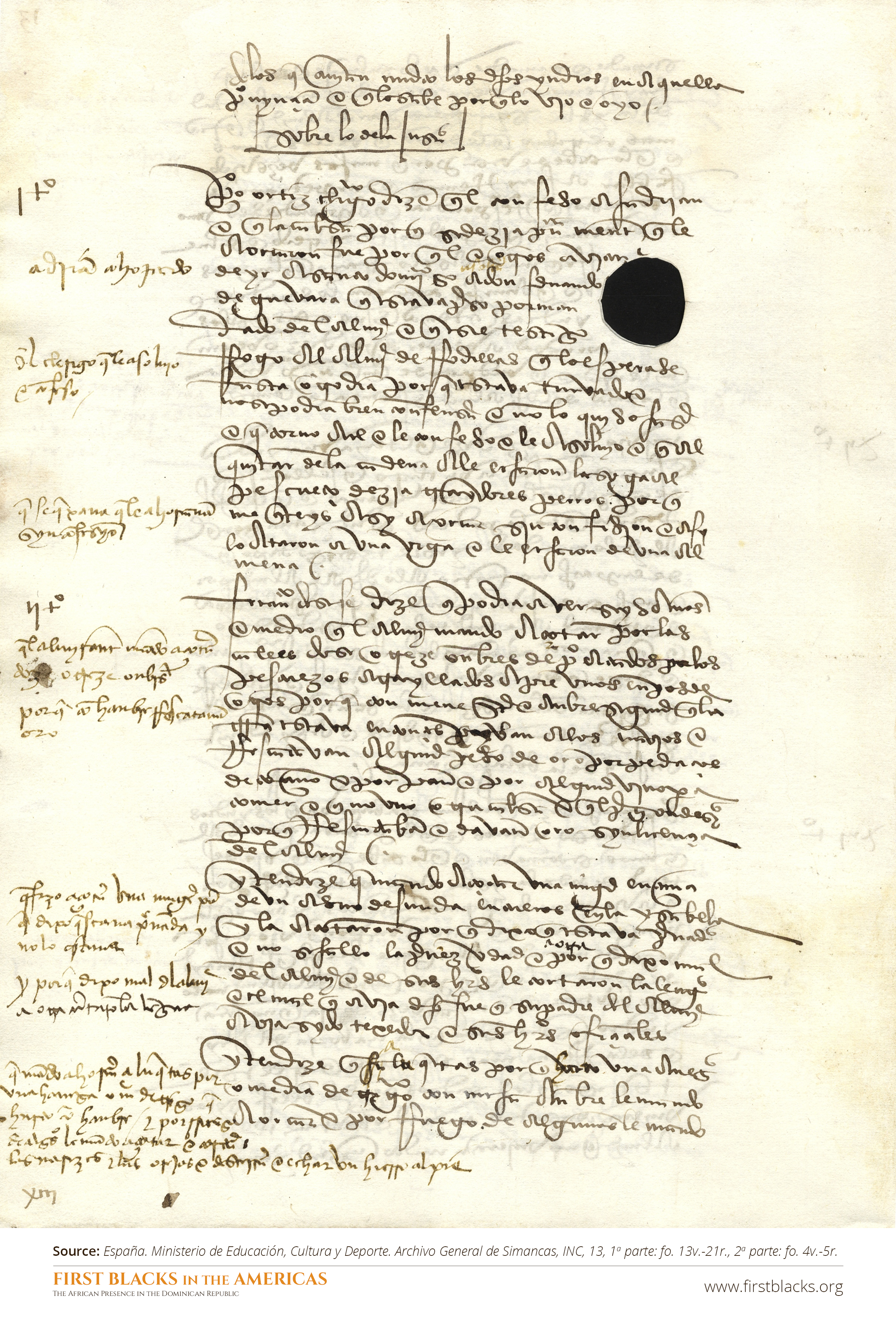The archival manuscripts
 The main, and most abundant, primary sources of information about the inhabitants of La Española (Black and otherwise) during the centuries of its colonial period, which is the same as to say its early period of formation as a multiethnic society in modern times, are the manuscripts or hand-written documents produced by those who enjoyed the social privilege of having learned how to write during those times. They were for the most part the bureaucrats of the Spanish empire residing in the colony of La Española as well as some of the colonists of Spanish or other European origins, their offspring born in the colony, and some of those among the non-White population who were not subjected to the oppression of slavery.
The main, and most abundant, primary sources of information about the inhabitants of La Española (Black and otherwise) during the centuries of its colonial period, which is the same as to say its early period of formation as a multiethnic society in modern times, are the manuscripts or hand-written documents produced by those who enjoyed the social privilege of having learned how to write during those times. They were for the most part the bureaucrats of the Spanish empire residing in the colony of La Española as well as some of the colonists of Spanish or other European origins, their offspring born in the colony, and some of those among the non-White population who were not subjected to the oppression of slavery.
The data about the Black people of La Española contained in those documents, therefore, are almost always written down by non-Blacks and the non-enslaved, and probably reflect whatever worldview informed how the authors perceived the Black people of the colony as well as society and the world in general at the time. This general social mentality probably informed what they wrote and what they did not write, what they considered worth recording and not worth recording as inhabitants of La Española. Every now and then we find mentions of utterances and words reportedly said by Blacks and enslaved Blacks in testimonies about themselves or about others that were ultimately written down, overwhelmingly, by non-Black and non-enslaved individuals.
The main challenge that these manuscripts pose to the general readers of our time consists of the peculiar handwriting styles they were written in, which at the time were not absolutely uniform but actually four different styles, in each of which the calligraphy or the scripting of each letter was rather different from the style that finally made it to our time as the prevalent one. This difference renders the reading and deciphering of the said manuscripts almost impossible, or at least so labor-intense as to discourage most potential readers from engaging with them. As a result, possibly hundreds of thousands of folios or pages of documentation that say things about the Black people of La Española during the centuries of the modern period, have remained and still remain unstudied or unknown, the historical experience of those ancestors of today’s Black and mixed-race Dominicans remaining in oblivion.
In this context, the knowledge of and training in paleographic reading, that is, teaching people how to decipher these old handwriting styles, becomes fundamental for expanding the research and discovery of new information on the early Blacks of La Española and the Americas. It is a kind of training that for too long has been sequestered in Ph.D. and advanced-degree education programs in the humanities and the social sciences in universities and other sites of higher education. In reality it is a learning process perfectly achievable by any individual with a basic command of reading in Spanish. The CUNY Dominican Studies Institute is trying to contribute to such broader outside-the-university learning, in what we see as a democratizing of historical knowledge, through the online platform called the Spanish Paleography Digital Teaching and Learning Tool launched by CUNY DSI in 2013 with support from the National Endowment for the Humanities.
The archival originals of most of the manuscripts contained in First Blacks in the Americas come from the Archivo General de Indias de Sevilla and, in a lesser proportion, the Archivo Histórico Provincial de Sevilla, both located in the city of Seville, in Spain, the former commercial capital of the Spanish empire during the entire 16th century. Others are held at the Archivo Diocesano de Santo Domingo, in Santo Domingo, Dominican Republic. A great deal of the manuscripts from Archivo General de Indias were found by the CUNY DSI research team in the large PARES-Portal de Archivos Españoles (the Spanish Online Historical Archives Database). Others come from the CUNY Dominican Studies Institute's Dominican Colonial Documents Collection, formed by copies of manuscripts purchased from the Archivo General de Indias and not necessarily installed yet in PARES at the time of our research. To view a general list of all manuscripts used in this website, please click here.
Except where otherwise indicated, all paleographical transcriptions contained in First Blacks in the Americas are the work of Anthony R. Stevens-Acevedo, Assistant Director of CUNY Dominican Studies Institute.
